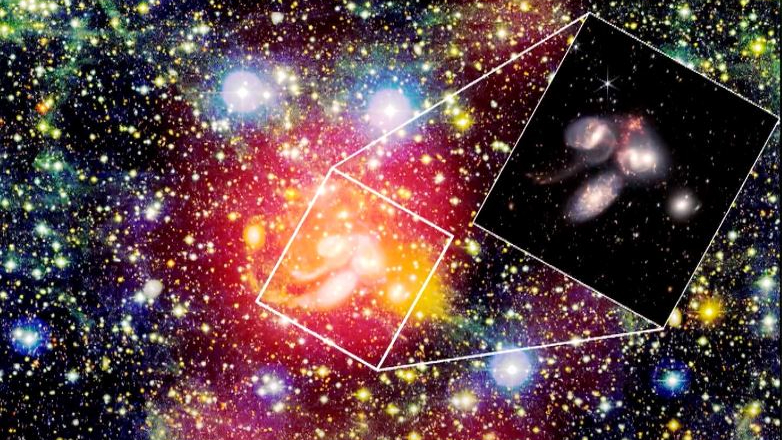The further scientists conduct space research, the more they discover. This contains unprecedented interplanetary architecture. Stephan's quintet, a collection of galaxies, was discovered in 1877 and continues to fascinate scientists. It was one of the JWST's initial scientific objectives. The Five-Hundred-meter Aperture Spherical Telescope (FAST) has now discovered the biggest known atomic gas structure around a group of galaxies.
China's 'Sky Eye' radio telescope detected the universe's biggest atomic cloud. The findings of an international team led by Chinese experts on this massive cloud have been released. It is composed of hydrogen atoms, spans two million light years, and is 20 times the size of our Milky Way galaxy, as reported by Phys.
The structure extends approximately 2 million light-years, a surprising distance considering how close the Andromeda galaxy is to our own, the Milky Way. In terms of our galaxy, nearly 20 Milky Ways might fit side by side throughout this incredibly low-density cloud.
Biggest Cloud Structure Discovered
This is the biggest atomic gas structure ever discovered orbiting a galaxy group stated by XU Cong of the Chinese Academy of Sciences in a press release. The remarkable capabilities of FAST enabled the discovery of this formation. Atomic hydrogen gas is essential to the creation of all-stars. It is easily ejected out of galaxies, particularly during merger processes.
In the instance of Stephan's quintet, four of the five galaxies collide simultaneously (the fifth just appears close by). The core group is 290 million light-years distant from Earth.
These interactions are really complicated. The basic architecture of galaxies may be drastically altered, and their supermassive black holes can undergo a feeding frenzy. The James Webb Space Telescope was able to monitor numerous fascinating compounds, including sulfur and oxygen, surrounding one of the galaxies' supermassive black holes. The gas is also ejected and spreads throughout intergalactic space. These and other significant claims are published in the scientific journal Nature.
The Chinese radio telescope enabled the researchers to see the distribution of this gas for the first time, revealing that the structure is considerably greater than anybody could have predicted.

ALSO READ : President Joe Biden to Unveil NASA James Webb Space Telescope's First 5 Photos of the Universe
How Big Is This Cloud Structure?
A light year is a division of dimensions for space rather than duration. It represents the distance traveled by a light beam traveling in a straight path in one year.
Imagine the Earth's diameter (40,000 km), stretch it down in a single direction, multiply it by 7.5, and then connect 31.6 million such lines. This amounts to 9.5 trillion kilometers. Alternatively, one light year. Multiply this just by two million to get the size of such an atomic cloud.
The 'China Sky Eye,' also known as the Five-hundred-meter Aperture Spherical Radio Telescope (FAST), is the world's biggest radio telescope and is located in Guizhou, southwest China, in a natural basin. Its sensitivity to particular electromagnetic frequencies is its greatest strength, as reported by IFL Science.
The findings state that there may be additional large-scale, low-density atomic gas formations in space. It might also help scientists comprehend the genesis of galaxies and show analogous more large-scale, low-density atomic gas configurations that exist throughout space.
According to the researchers, this scattered structure was most likely caused by tidal interactions during the early phases of Stephan's Quintet development. Diffusion happens in gasses and liquids when they collide with enough energy spontaneously and spread out. NASA's James Webb Space Telescope has published images that show a comprehensive view of Stephan's Quintet and demonstrate how the interacting galaxies promote cloud formation among themselves and how gas in galaxies is disrupted, following the report from CGTN.
RELATED ARTICLE: Cyprus Space Exploration Organization Simulcasts James Webb Space Telescope First Images
Check out more news and information on Space in Science Times.
© 2026 ScienceTimes.com All rights reserved. Do not reproduce without permission. The window to the world of Science Times.











